Warehouse Robotics Market Size
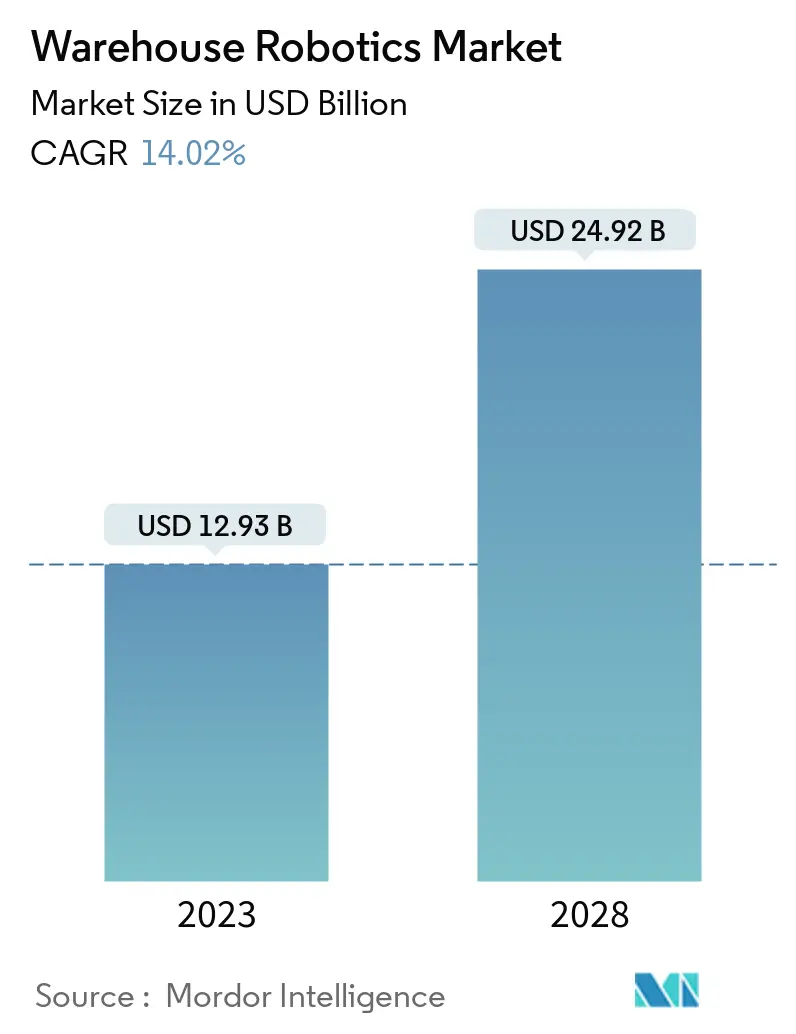
| Study Period | 2018 - 2028 |
| Market Size (2023) | USD 6.74 Billion |
| Market Size (2028) | USD 15.22 Billion |
| CAGR (2023 - 2028) | 17.70 % |
| Fastest Growing Market | Asia Pacific |
| Largest Market | Asia Pacific |
Major Players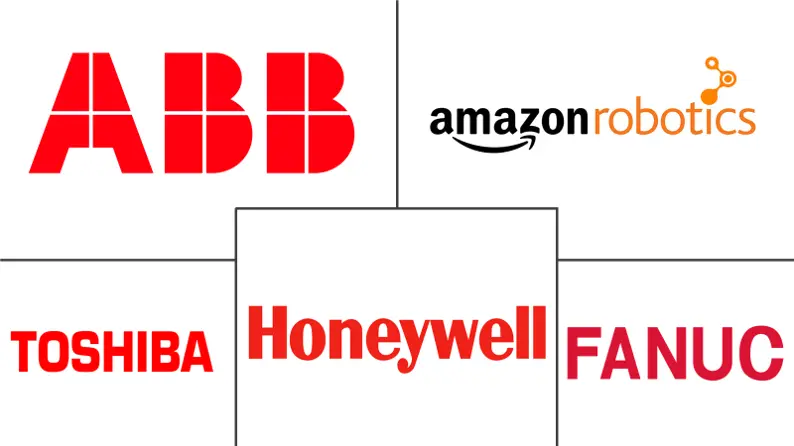
*Disclaimer: Major Players sorted in no particular order |
Need a report that reflects how COVID-19 has impacted this market and its growth?
Warehouse Robotics Market Analysis
The Warehouse Robotics Market size is expected to grow from USD 6.74 billion in 2023 to USD 15.22 billion by 2028, at a CAGR of 17.70% during the forecast period (2023-2028).
The emergence of the Industrial Internet of Things (IIoT) and the advent of a network of connected systems are helping industries perform a multitude of tasks, such as material batching, picking, ordering, packaging, warehouse security, and inspection, as well as improve the operational efficiency by huge margins.
- The growth in the e-commerce industry worldwide and the growing need for efficient warehousing and inventory management are driving the market's growth. Automation in warehousing offers extreme convenience in cutting down overall business costs and reducing errors in product deliveries. According to DHL, a prominent 3PL company and a significant end-user of warehouse automation solutions, despite the advantages, 80% of warehouses are “still manually operated with no supporting automation.” Further, warehouses that use conveyors, sorters, and pick and place solutions, among other equipment (not necessarily automated), account for 15% of total warehouses. In contrast, only 5% of current warehouses are automatic.
- Significant technological advancements, such as sensor technologies that enable an enhanced object perception and an accurate positioning system, have made way for the robotics industry to explore the untapped potential in various warehousing applications while attaining an optimal operational flow and logistics efficiency, among other accomplishments, across the different industry verticals.
- According to the Bank of America, by 2025, 45% of all manufacturing tasks will be executed by robotic technology. With this emerging trend, large firms, such as Raymond Limited, a prominent Indian textile company, and Foxconn Technology, a China-based supplier for large technology manufacturers like Samsung, have replaced 10,000 and 60,000 workers, respectively, by incorporating automated technology into their factories.
- These factors have directly impacted the increasing adoption of warehouse robotics. The rising number of warehouses and increasing investments in warehouse automation, coupled with the global rise in labor costs and availability of scalable technological solutions, have been driving the market for warehouse robots worldwide. For instance, prominent logistics brands in the United States, like DHL, XPO Logistics, and NFI Logistics, are investing in expansion activities, despite the adverse commercial renting climate.
- During the COVID-19 outbreak, robots and automation played a critical role in managing the situation. Further, the situation is likely to bring new opportunities to the market. Ocado, a British online grocer, aims to make its warehouse robotics and grocery home-delivery technology available to other supermarkets for a licensing fee. Since May 2020, many warehouse sites have recovered after starting their operations post lockdown. However, the fluctuations caused in the starting four months of 2020 could result in order delays and lead time across the warehouse robotics supply chain throughout the year.
- While significant advances have been accomplished in robotics, the human workforce still holds the upper hand in running a well-organized warehouse. Forecast of long-term labor shortages across the United States and Europe and sustained pressure on supply chains to deliver orders quickly and more precisely caused operations executives to seriously assess that question as they look for answers to staffing challenges.
Warehouse Robotics Market Trends
This section covers the major market trends shaping the Warehouse Robotics Market according to our research experts:
Increasing Number of SKUs
- An increasing number of SKUs (stock-keeping units) is quite common in the industry, as there is a constant introduction of new products regularly. The luxury of customization and the growing number of consumer choices through the e-commerce platform pushed the demand for an expanded inventory, with a host of options and styles available at the disposable of e-commerce retailers for dispatch on request.
- According to the Materials Management & Distribution Report, just-in-time ordering, direct-to-consumer distribution, and shifting retailer-wholesaler relationships decrease the number of large-pallet orders received by distributors. Thus, the growth of small, multiple SKU orders is forcing warehouses to automate.
- Automated, efficient mini-load storage and retrieval systems (AS/RS) address this market challenge by employing lightweight cranes that can sort individual totes, cases, trays, and crates while optimizing storage and releasing key delivery and labor resources. These systems maximize supply chain efficiency through the automation of key processes, including goods arrival, maximized inventory storage, and the fulfillment of outbound shipping orders.
- With warehouses experiencing long-term labor shortages and increasing demand due to the booming e-commerce industry, companies are turning to warehouse automation hardware and software solutions to stay competitive in an uncertain and challenging economic landscape.
- With huge investment in the movement of goods through the world's warehouses, security is an ongoing concern. Thus, warehouse security robots are expected to gain traction in the coming years. Warehouse security robots are designed to automate perimeter security's dull and dangerous functions while empowering humans for higher-level tasking like remote robotic vehicle operation and monitoring. The increase in size helps warehouses cope with higher volumes and a growing number of SKUs.
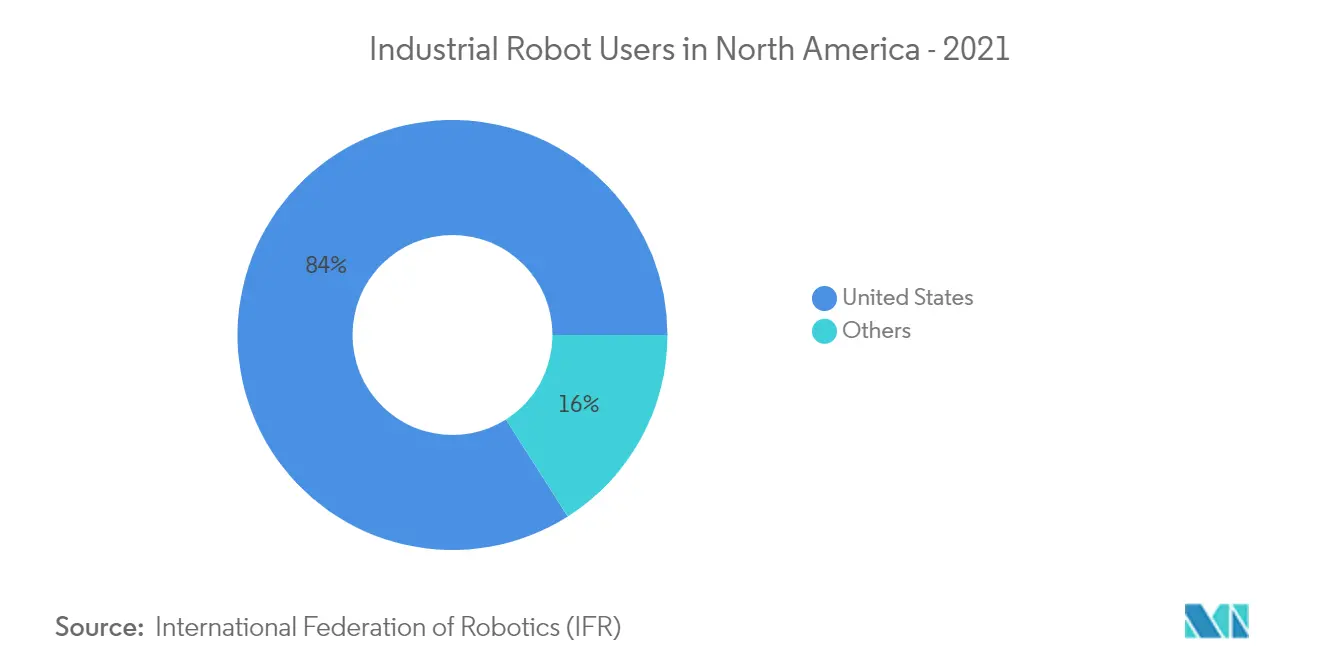
Asia-Pacific is Expected to Hold Significant Market Share
- The manufacturing sector is expected to account for a significant market share and become one of the key contributors in the region, with investments in the industry growing massively. In China, companies that have already deployed these robots in their warehouses witnessed the results during the pandemic. JD.com, a Chinese e-commerce giant based out of Wuhan, has been using a fleet of robotic vehicles in its automated warehouses to deliver essential goods to residents shopping online during lockdowns. The company claims that it witnessed an increase in the daily orders from about 600,000 to double in a single week during the pandemic.
- According to IFR, the operational stock of industrial robots is expected to reach 3,788 (in thousand units) by 2021 from 2,408 (in thousand units) in 2018. For instance, Alibaba, the world's largest retailer based out of China, upgraded to robotic labor in one of its warehouses, drastically reducing the labor workforce by 70% and creating an opportunity for a highly-skilled workforce.
- South Korea's population is aging rapidly. By the middle of this century, it will have one of the oldest populations out of all Organisation for Economic Co-operation and Development countries, just behind Japan, Italy, and Greece. Due to this, most manufacturing units are implementing industrial robots to maintain competitiveness.
- The South Korean government has taken measures to boost the country's small and mid-size manufacturing companies, including establishing 30,000 smart factories by 2022. The government expects small- and mid-size firms in the manufacturing industry to create 66,000 jobs by automating 50% of their manufacturing facilities and increasing KRW 18 trillion (USD 16 billion) in sales.
- Japan has continuously maintained its position as the world's top exporter of robots in terms of the value of shipments and the number of operating units. For instance, Fuji Yusoki Kogyo Co. Ltd, a Japan-based development and manufacturing palletizing robots company, sold over 16,000 robots worldwide. The company has a market share of 63% in the robotic palletizing industry of Japan and more than 20% market share in the world’s robotic palletizing industry.
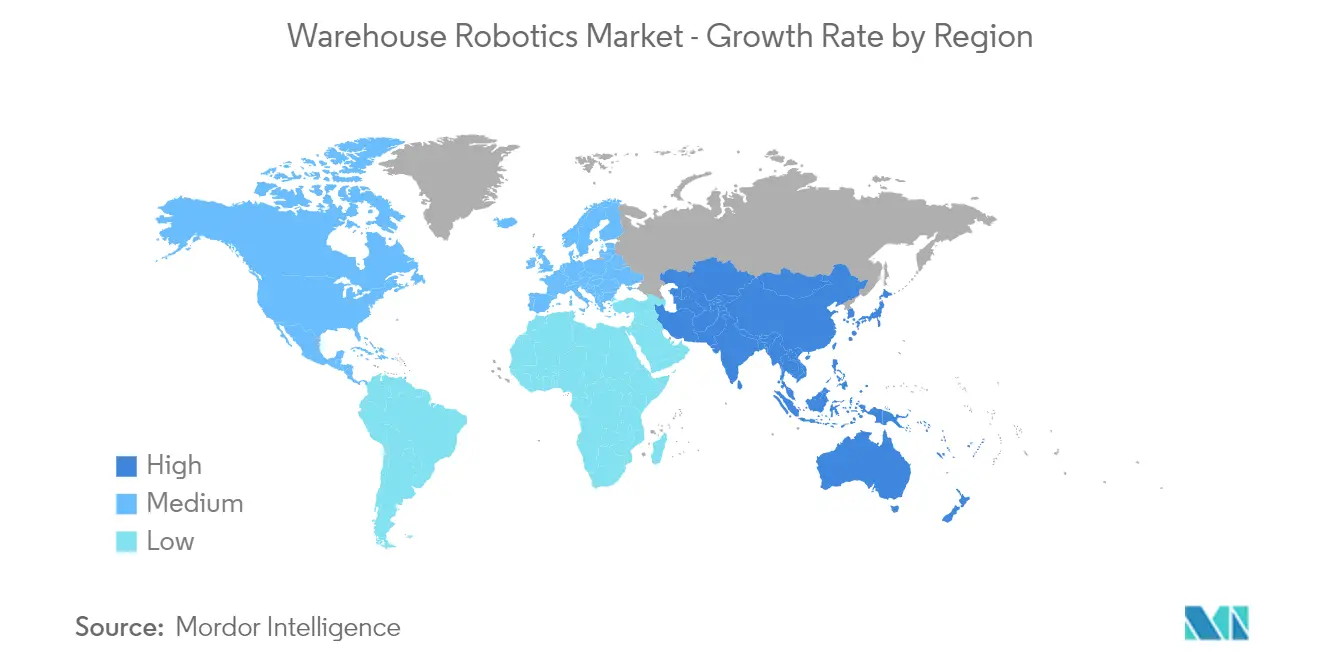
Warehouse Robotics Industry Overview
The warehouse robotics market is moderately fragmented and consists of highly competitive players. In terms of market share, a few of the major players, such as ABB Ltd, Honeywell, and Kiva Systems, currently dominate the market. These major players with a significant share in the market are expanding their customer base across various regions. Many companies are forming strategic and collaborative partnerships with various start-up companies to increase their market share and profitability.
- September 2021 - ABB introduced the ‘FlexBuffer’ robotic work cell for e-commerce supply chain operations. FlexBuffer provides new levels of flexibility for logistics, food and beverage, healthcare, consumer packaged goods, restaurants, and retailers. It offers a highly adaptable multi-functional solution to handle various tasks (such as sequencing, buffering, and storage) and for order consolidation.
- March 2021 - TGW implemented a highly automated end-to-end fulfillment solution for the Swedish catering wholesaler Martin & Servera in Norrköping, Sweden, which will be completed in March 2022. The end-to-end solution designed and implemented by TGW comprises a shuttle system with more than 35,000 storage locations in two temperature zones (ambient and chilled ). The design using triple-deep storage of totes ensures high-density storage of goods.
Warehouse Robotics Market Leaders
ABB Limited
Kiva Systems (Amazon Robotics LLC)
Honeywell International Inc.
Toshiba Corporation
Fanuc Corporation
*Disclaimer: Major Players sorted in no particular order
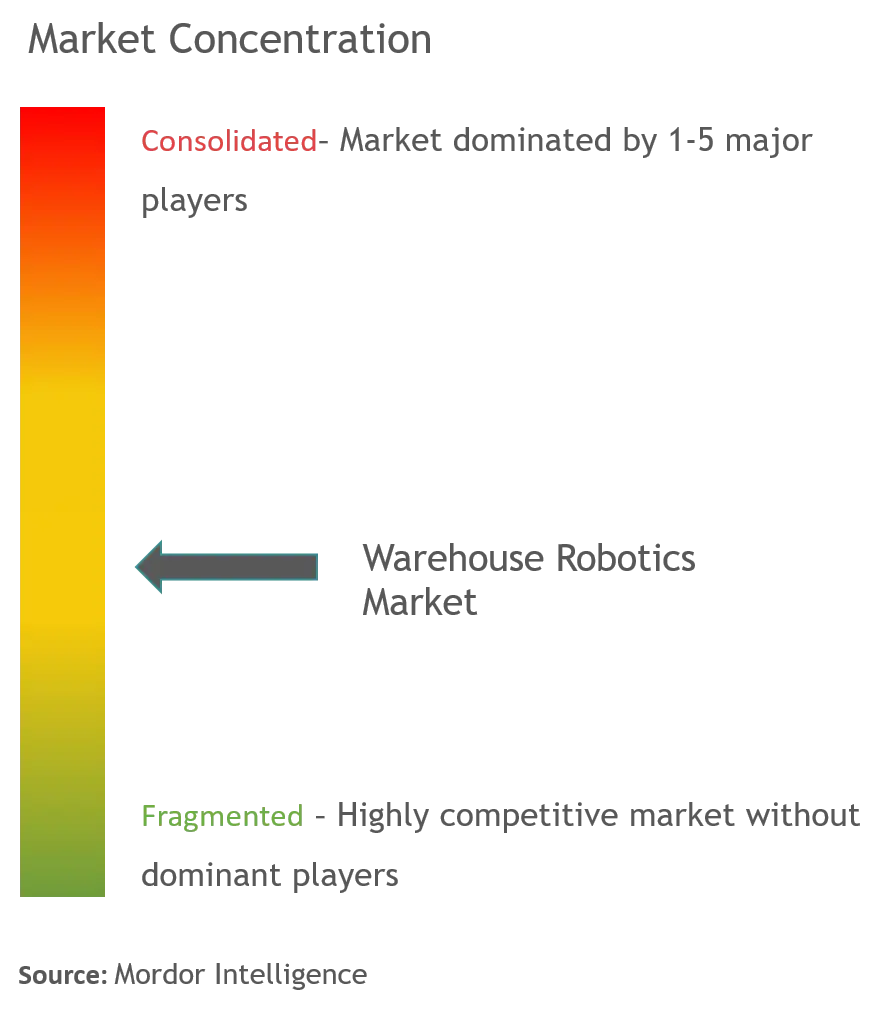
Warehouse Robotics Market News
- August 2022 - GEODIS and Locus Robotics announced entering a new expansion agreement to install 1,000 LocusBots at GEODIS’ worldwide warehouse locations over the next 24 months.
- June 2022 - Amazon.com Inc. detailed a set of new warehouse robots, Proteus and Cardinal, that its engineers have developed to increase the efficiency of its fulfillment centers. The systems are designed to help with the task of processing e-commerce packages.
- November 2021 - FANUC America Corporation is a subsidiary of Japan's FANUC Corporation. Robots, CNC components, and ROBOMACHINE systems are manufactured for various organizations in different industries, including the industrial sector. The new tiny LR-10iA/10 robot from FANUC is the company's most recent addition. The robot is intended for applications like machine tending and warehousing/logistics. In warehousing and logistics markets, the demand for a robot capable of effective machine tending has increased.
- September 2021 - Honeywell announced the launch of robotic technology that can automate the unloading of pallets, reducing the potential for injury and mitigating the effects of labor shortages. Its new Smart Flexible Depalletizer is driven by machine learning and advanced vision and perception technologies to fill in for the thousands of pallets picked by hand in warehouses across many countries every day.
Warehouse Robotics Market Report - Table of Contents
1. INTRODUCTION
1.1 Study Assumptions and Market Definition
1.2 Scope of the Study
2. RESEARCH METHODOLOGY
3. EXECUTIVE SUMMARY
4. MARKET DYNAMICS
4.1 Market Overview
4.2 Industry Attractiveness - Porter's Five Forces Analysis
4.2.1 Threat of New Entrants
4.2.2 Bargaining Power of Buyers
4.2.3 Bargaining Power of Suppliers
4.2.4 Threat of Substitute Products
4.2.5 Intensity of Competitive Rivalry
4.3 Industry Value Chain Analysis
4.4 Assessment of the Impact of COVID-19 on the Industry
4.5 Market Drivers
4.5.1 Increasing Number of SKUs
4.5.2 Increasing Investments in Technology and Robotics
4.6 Market Challenges
4.6.1 Stringent Regulatory Requirements
4.6.2 High Cost
5. MARKET SEGMENTATION
5.1 Type
5.1.1 Industrial Robots
5.1.2 Sortation Systems
5.1.3 Conveyors
5.1.4 Palletizers
5.1.5 Automated Storage and Retrieval System (ASRS)
5.1.6 Mobile Robots (AGVs and AMRs)
5.2 Function
5.2.1 Storage
5.2.2 Packaging
5.2.3 Trans-shipment
5.2.4 Other Functions
5.3 End-user Industry
5.3.1 Food and Beverage
5.3.2 Automotive
5.3.3 Retail
5.3.4 Electrical and Electronics
5.3.5 Pharmaceutical
5.3.6 Other End-user Industries
5.4 Geography
5.4.1 North America
5.4.1.1 United States
5.4.1.2 Canada
5.4.2 Europe
5.4.2.1 United Kingdom
5.4.2.2 Germany
5.4.2.3 France
5.4.2.4 Rest of Europe
5.4.3 Asia-Pacific
5.4.3.1 China
5.4.3.2 South Korea
5.4.3.3 Japan
5.4.3.4 Rest of Asia-Pacific
5.4.4 Latin America
5.4.5 Middle-East and Africa
6. COMPETITIVE LANDSCAPE
6.1 Company Profiles
6.1.1 ABB Limited
6.1.2 Kiva Systems (Amazon Robotics LLC)
6.1.3 TGW Logistics Group GMBH
6.1.4 Singapore Technologies Engineering Ltd (Aethon Incorporation)
6.1.5 InVia Robotics Inc.
6.1.6 Fanuc Corporation
6.1.7 Honeywell International Incorporation
6.1.8 Toshiba Corporation
6.1.9 Omron Adept Technologies
6.1.10 Yaskawa Electric Corporation (Yaskawa Motoman)
6.1.11 Kuka AG
6.1.12 Fetch Robotics Inc.
6.1.13 Geek+ Inc.
6.1.14 Grey Orange Pte Ltd
6.1.15 Hangzhou Hikrobot Technology Co. Ltd
6.1.16 Syrius Robotics
6.1.17 Locus Robotics
- *List Not Exhaustive
7. INVESTMENT ANALYSIS
8. FUTURE OF THE MARKET
Warehouse Robotics Industry Segmentation
Warehouse robotics is the usage of automated robots and specialized software to transport materials, perform various tasks, and streamline or automate the entire warehouse process. In recent years, robotics gained significant importance in supply chains, distribution centers, and warehouse management circles. It continues to play a significant role in warehouse automation. The Warehouse Robotics Market is Segmented by Type (Industrial Robots, Sortation Systems, Conveyors, Palletizers, Automatic Storage and Retrieval Systems, and Mobile Robots), Function (Storage, Packaging, Transshipment, and Other Functions), End-user Industry (Food and Beverage, Automotive, Retail, Electrical and Electronics, Pharmaceutical, and Other End-user Industries), and Geography.
| Type | |
| Industrial Robots | |
| Sortation Systems | |
| Conveyors | |
| Palletizers | |
| Automated Storage and Retrieval System (ASRS) | |
| Mobile Robots (AGVs and AMRs) |
| Function | |
| Storage | |
| Packaging | |
| Trans-shipment | |
| Other Functions |
| End-user Industry | |
| Food and Beverage | |
| Automotive | |
| Retail | |
| Electrical and Electronics | |
| Pharmaceutical | |
| Other End-user Industries |
| Geography | ||||||
| ||||||
| ||||||
| ||||||
| Latin America | ||||||
| Middle-East and Africa |
Warehouse Robotics Market Research FAQs
How big is the Warehouse Robotics Market?
The Warehouse Robotics Market size is expected to reach USD 6.74 billion in 2023 and grow at a CAGR of 17.70% to reach USD 15.22 billion by 2028.
What is the current Warehouse Robotics Market size?
In 2023, the Warehouse Robotics Market size is expected to reach USD 6.74 billion.
Who are the key players in Warehouse Robotics Market?
ABB Limited, Kiva Systems (Amazon Robotics LLC), Honeywell International Inc., Toshiba Corporation and Fanuc Corporation are the major companies operating in the Warehouse Robotics Market.
Which is the fastest growing region in Warehouse Robotics Market?
Asia Pacific is estimated to grow at the highest CAGR over the forecast period (2022-2028).
Which region has the biggest share in Warehouse Robotics Market?
In 2022, the Asia Pacific accounts for the largest market share in Warehouse Robotics Market.
Warehouse Robotics Industry Report
Statistics for the 2023 Warehouse Robotics market share, size and revenue growth rate, created by Mordor Intelligence™ Industry Reports. Warehouse Robotics analysis includes a market forecast outlook to 2028 and historical overview. Get a sample of this industry analysis as a free report PDF download.
